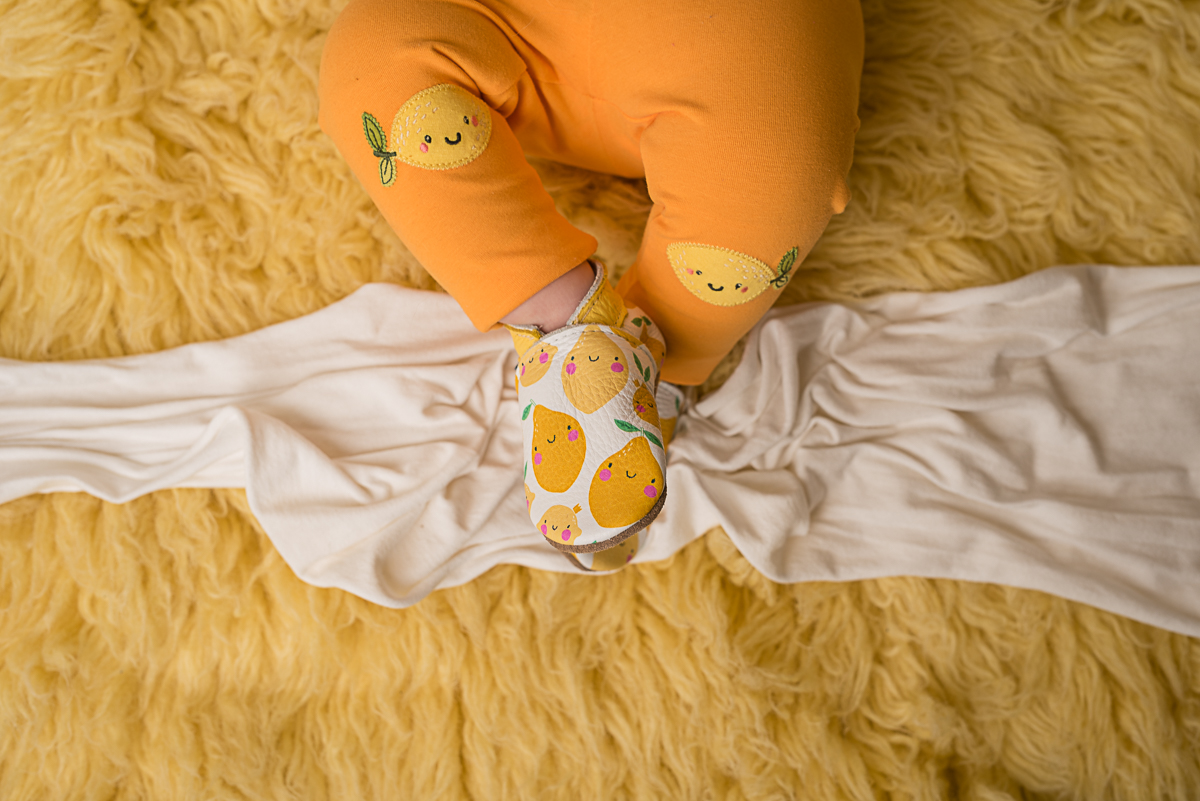When Do Babies Find Their Feet?

During their first year, babies achieve many important sensory and motor milestones, filling you with love and pride as a new parent or grandparent. You’ll love watching your little one grow in a whirlwind of progress paving the way for independent walking. If you’ve ever asked yourself ‘When do babies find their feet?’, our latest Inch Blue blog is here to walk you through the most important developmental stages. Plus, we’ll introduce you to newborn baby shoes to set your little wrigglers on the right path.
Small sensory steps – when do babies find their feet?
Babies rapidly develop their senses in their first year, with all newborn senses working together to prepare them for walking. From birth, they explore their world through touch, learning about shapes and textures as they feel their way with little fingers and tiny toes.
Babies getting to grips with sensory skills is crucial for them to develop the confidence to walk. Their vision matures quickly, going from seeing light and dark at birth to being able to focus and track objects from around 3 to 4 months old.
Good vision is essential to help baby judge distances and plan movements, all key for taking those first, unforgettable steps. Equally important is your baby’s ability to balance, which starts to refine throughout their first year. You’ll find by around 4 to 6 months, most babies can hold their head steady and control their upper body movements, which is crucial for maintaining a stable upright position while learning to find their feet.
Mastering motor skills – building blocks to first steps
In their first year, babies also develop amazing motor skills in a specific order. These stages are the firm foundation for walking. Like building blocks, they begin to develop from around 3 months onwards, when babies start to strengthen their neck and back muscles. This helps them to hold their head up and prepare for the upright posture they’ll need to find their feet.
By 4 to 6 months, you might notice curiosity gets the better of your baby and they begin to roll around the floor. Yikes! Once you’ve got over the shock of having a little one on the move, you can enjoy this exciting stage as they develop core strength and coordination. Propelling themselves by rolling towards toys, or you, or your pet introduces weight shifting, another crucial skill they’re getting in the bag ready for walking!
Next comes sitting, often mastered between 6 and 9 months of age. This is key to strengthening their core - helping your baby balance while standing and walking. Crawling or scooting, which develops between 6 and 10 months, allows for exploration, builds leg and arm strength, and practices weight distribution – all vital for turning wobbles into steps.
Finally, some babies will pull themselves up by around 8 to 10 months, demonstrating the upper body and leg strength needed to initiate and maintain stable walking. We love our heart baby shoes for this pre-walking stage, helping them to feel and grip the ground beneath their feet.
Newborn babies’ foot and leg reflexes
You might have spotted the fascinating reflexes in the feet and legs of newborn babies. These involuntary movements are triggered by specific stimuli and look very cute but have the purpose of helping them develop the nervous system:
- Grasp reflex is when a baby's toes curl inwards like a finger grip when you stroke the sole of the foot. This helps with balance.
- Babinski reflex is when a baby extends their big toe and their other toes splay when the bottom of the foot is stroked from heel to toe.
- Stepping reflex is alternating leg movements when you hold your newborn upright with their feet barely touching a flat surface. This is also a precursor to walking.
Little explorers – when do babies find their feet?
Be prepared, babies at 3 to 4 months old become fully intrepid explorers! Around this time they gain control of their legs, then start to bring their feet into view with curiosity and grasping fascination. They will kick more and bring their feet to their mouths. They begin to grab at objects and show growing curiosity about their bodies and the world. You’ll literally see them find their feet!
At around 5 to 6 months of age, babies gain more control, bending their knees right up and even grabbing their toes. This newfound fascination isn't only fun, it's important sensory learning. Mouthing their feet teaches your newborn baby about texture and shape whilst touching everything with their toes builds crucial brain connections and builds the notion of future movement.
All the fun of truly starting to find their feet
By 7 to 9 months, your baby has found and made friends with their feet! Building on their earlier explorations, babies develop even greater control of their feet. They can grasp, hold, and manipulate with precision, showcasing fine motor skills they’ve developed in their tiny toes. This newfound control makes for fun, games, and exploration. You may notice they use their feet to scoot forward or shunt a toy. Expect lots of giggles as they grow, feeling good about their increased skills and rewarded curiosity. Who knew feet were such fun?!
This exploration of their feet is 100% adorable but also a vital step in a baby's development. By bringing their feet firmly into focus – and use - babies are building the foundation for future skills like rolling over, crawling, and eventually, walking. So, next time your little one is engrossed in their feet, they're not just playing; they're learning about the world, their bodies, and what steps they’re going to take next!
Baby shoes from Inch Blue
You can help your newborn find their feet with Inch Blue shoes. Our soft newborn baby shoes in soft leather and suede are the next best thing to barefoot walking for your baby’s feet. Non-restrictive but fully supportive to keep little feet cosy and snug, our baby boy and baby girl booties stay on, and are non-slip to help babies feel and grip the ground in the cutest bold designs and bright colours to suit every little one who’s trying to find their feet.
